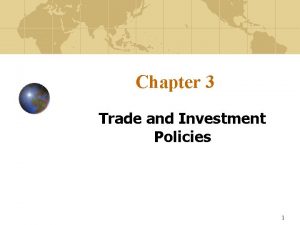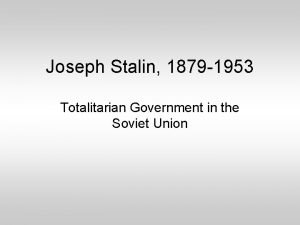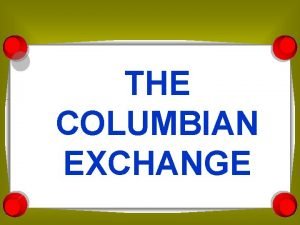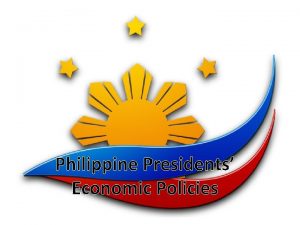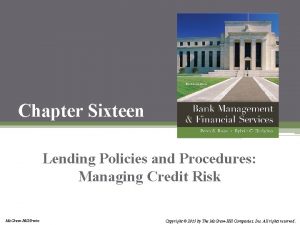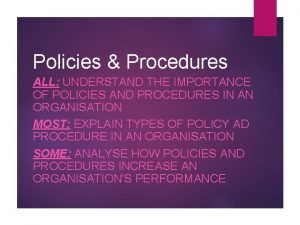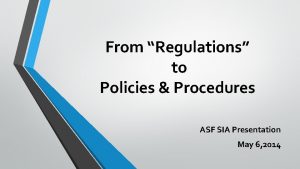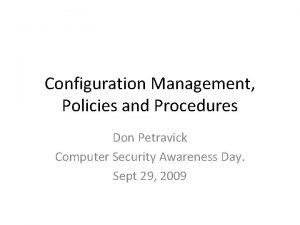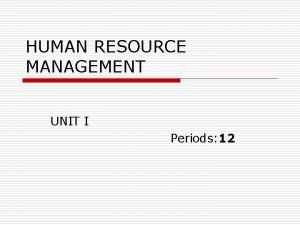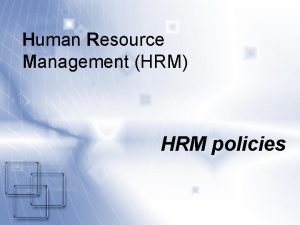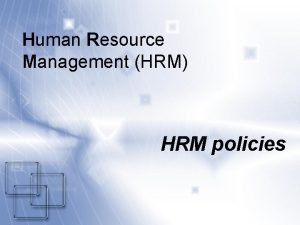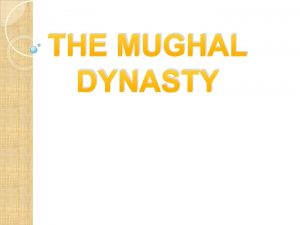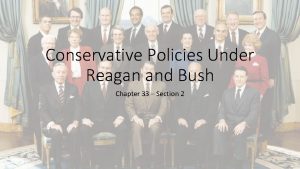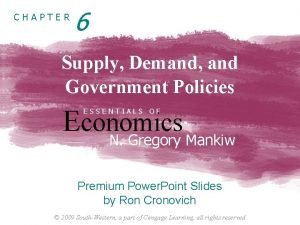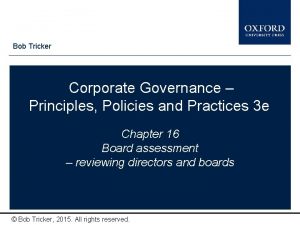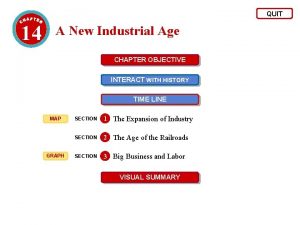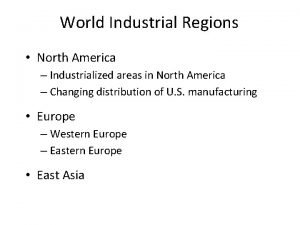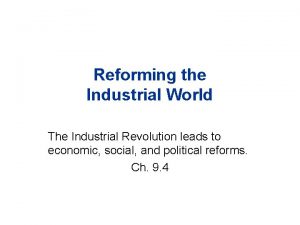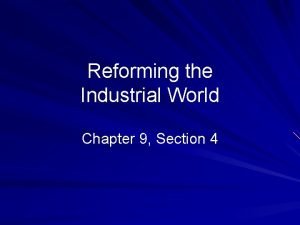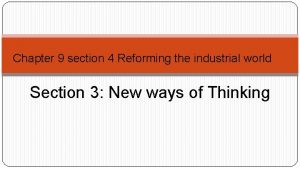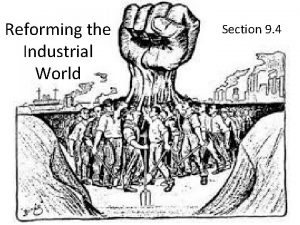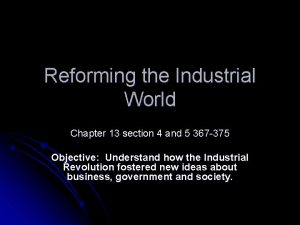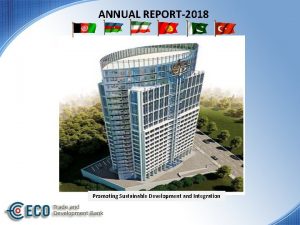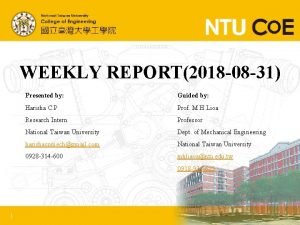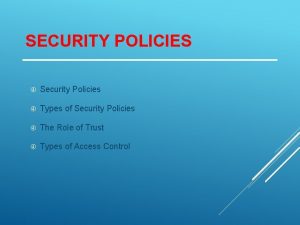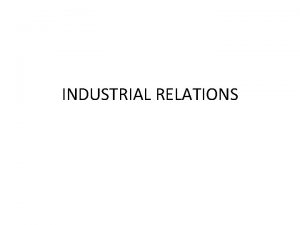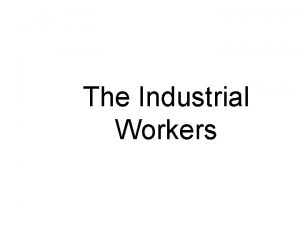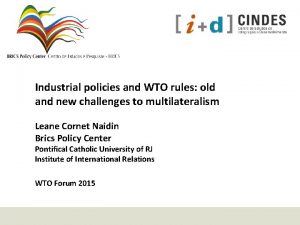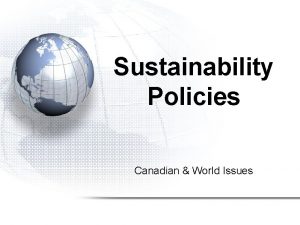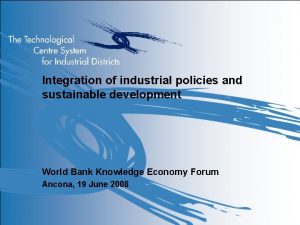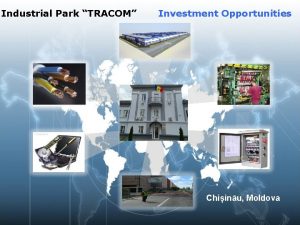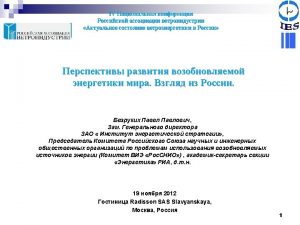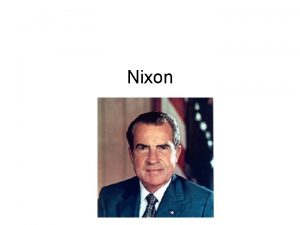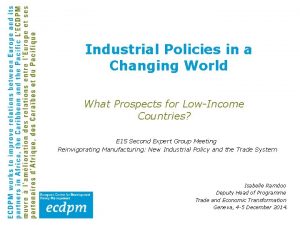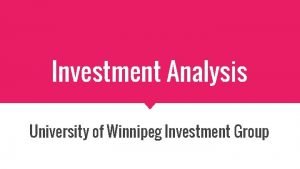WORLD INVESTMENT REPORT2018 INVESTMENT AND NEW INDUSTRIAL POLICIES









































- Slides: 41

WORLD INVESTMENT REPORT-2018 INVESTMENT AND NEW INDUSTRIAL POLICIES PROF. DR. GÜLÜZAR KURT GÜMÜŞ

WORLD INVESTMENT REPORT PAST ISSUES 1991 -2018

INVESTMENT TRENDS AND PROSPECTS

Global foreign direct investment (FDI) flows fell by 23 per cent to $1. 43 trillion! • caused in part by • a 22 per cent decrease in the value of crossborder mergers and acquisitions (M&As). • a 14 per cent decrease in the value of announced greenfield investment – an indicator of future trends. • Decrease is in contrast to the accelerated growth in GDP and trade. • The sharp fall in global FDI contrasted with the trend in other cross-border capital flows. • Total capital flows increased from 5. 6 to 6. 9 per cent of GDP, as bank lending and portfolio investment compensated for the FDI slump. • Capital flows to developing countries increased modestly, from 4. 0 to 4. 8 per cent of GDP.

Inward FDI flows to developed economies fell sharply, by 37 per cent, to $712 billion! Cross-border M&As registered a 29 per cent decrease, with fewer of the megadeals and corporate restructurings that shaped global investment patterns in 2016.

FDI flows to developing economies remained stable at $671 billion! FDI remains the largest external source of finance for developing economies. FDI flows to Africa continued to slide, reaching $42 billion Flows to developing Asia remained stable, at $476 billion the largest FDI recipient in the world FDI to Latin America and the Caribbean rose 8 per cent to reach $151 billion Flows to the least developed countries fell by 17 per cent, to $26 billion

FDI flows to transition economies declined by 27 per cent, to $47 billion, the second lowest level since 2005.

FDI activity was lower across all sectors ! • M&A values were down in the primary, manufacturing and services sectors. important implications for industrial development !!! • The fall in greenfield announcements in 2017 was concentrated in services. • However, over the past five years, the level of greenfield projects in manufacturing has been consistently lower than in the preceding five-year period across all developing regions.

A decrease in rates of return is a contributor to the investment downturn. • Return on investment is in decline across all regions, with the sharpest drops in Africa and in Latin America and the Caribbean. The global average return on foreign investment is now at 6. 7 per cent, down from 8. 1 per cent in 2012. • The lower returns on foreign assets may affect longer-term FDI prospect.

INVESTMENT POLICY DEVELOPMENTS

Many countries continued policy efforts aimed at attracting FDI! In 2017, 65 countries and economies adopted at least 126 investment policy measures, of which 84 per cent were favourable to investors. They liberalized entry conditions in a number of industries including transport, energy and manufacturing. They also promoted and facilitated investment by simplifying administrative procedures, providing incentives and establishing new special economic zones (SEZs)

Recently, an increasing number of countries have taken a more critical stance towards foreign investment! New investment restrictions or regulations in 2017 mainly reflected concerns about national security and foreign ownership of land natural resources. Some countries have heightened scrutiny of foreign takeovers, in particular of strategic assets and technology firms. Several countries are considering tightening investment screening procedures.

Investment treaty making has reached a turning point! The number of new international investment agreements (IIAs) concluded in 2017 (18) was the lowest since 1983. Moreover, for the first time, the number of effective treaty terminations outpaced the number of new IIAs. In contrast, negotiations for megaregional agreements maintained momentum, especially in Africa and Asia.

INVESTMENT AND NEW INDUSTRIAL POLICY

Build-up Strategy Adopted formal industrial developmen t strategies 40 per cent of industrial development strategies contain vertical policies for the build-up of specific industries Catch-up Strategy New-industrial-revolutionbased Strategy over a third focus on a quarter focus on horizontal competitivenesspositioning for the new enhancing policies designed industrial revolution to catch up to the productivity frontier

POLICY IMPLICATIONS FOR THE FUTURE

Key factors influencing future FDI flows • Economic Fundamentals • Policy factors • MNEs and IPAs (Investment Promotion Agencies)

• Investment policies need to evolve with industrial policies • new industrial policies need to make more effective use of investment policy instruments • investment policies need to modernize in line with new industrial development strategies

UNCTAD's IPFSD and the interaction between industrial and investment policies

GLOBAL FDI FIGURES AT A GLANCE

FDI inflows, global and by group of economies, 2005– 2017 (Billions of dollars and per cent) • #1: developed economies • No change in developing economies (stable) • Similar trend in world total and developed economies

FDI inflows, by region, 2016– 2017 (Billions of dollars and per cent • Upward trend: other developed economies, Latin America and Caribbean • #1 in dramatical drop: EU and North America • No change: developing economies and Asia

FDI inflows, top 20 host economies, 2016 and 2017 (Billions of dollars) • #1 US • 4 developing country in top-5 • Extreme improvement in Indonesia

FDI outflows, top 20 home economies, 2016 and 2017 (Billions of dollars) • #1 US (Net FDI outflow position) (275 -342) • 2 developing country in top-5 • US, China, Hong Kong, China (the same members with the former list) • Extreme improvement in UK

Inward FDI rates of return, 2012– 2017 (Per cent)

Selected indicators of FDI and international production, 2017 and selected years • • 597. 56 % change in FDI inflows 486. 06 % change in FDI outflows 1335. 51% change in FDI inward stock 1267. 53 % change in FDI outward stock • 356. 30 % change in sales of foreign affiliates • 170. 80 %change in employment by foreign affiliates • 240. 72 % change in GDP • 411. 05 % change in world exports

Investment policy tools in industrial development strategies, by type (Per cent of sample)

Recent industrial policy models Share of sample (per cent), and number of strategies per country grouping

Value and number of net cross-border M&As and announced greenfield FDI projects, 2008– 2017 (Billions of dollars and numbers)

Value and number of net cross-border M&As, by sector and selected industries, 2016– 2017

Value and number of announced FDI greenfi eld projects, by sector and selected industries, 2016– 2017

Value of announced FDI greenfield projects in manufacturing and share of manufacturing in all sectors, 2008– 2017 (Billions of dollars and per cent)

Global cross-border capital flows, 2014– 2017 (Per cent of GDP)

Global capital flows, 2002− 2017 (Per cent of GDP)

Sources of external finance, developing economies, 2005– 2017 (Billions of dollars)

Sources of external finance, developing economies and LDCs, 2013– 2017 (Per cent)

Selected indicators of FDI and international production, 2017 and selected years

Internationalization statistics of the 100 largest non-fi nancial MNEs, worldwide and from developing and transition economies (Billions of dollars, thousands of employees and per cent)

Composition of top 100 global MNEs by industry and home economy, 2012– 2017 (Number of fi rms)

Composition of top 100 MNEs from developing and transition economies by industry and home country, 2011 – 2016 (Number of fi rms)

Evolution of ICT MNEs in UNCTAD’s ranking of the top 100 MNEs, 2010– 2017 (Number of companies and share of assets and revenues)
 Antidumping laws
Antidumping laws Stalin's totalitarian state industrial policies
Stalin's totalitarian state industrial policies Fixed investment and inventory investment
Fixed investment and inventory investment Site:slidetodoc.com
Site:slidetodoc.com Are oranges old world or new world
Are oranges old world or new world Security program and policies principles and practices
Security program and policies principles and practices Recruitment selection and induction process
Recruitment selection and induction process Security program and policies principles and practices
Security program and policies principles and practices Security program and policies principles and practices
Security program and policies principles and practices Security program and policies principles and practices
Security program and policies principles and practices Security program and policies principles and practices
Security program and policies principles and practices Mobile world investment corporation
Mobile world investment corporation Quirino-foster agreement tagalog
Quirino-foster agreement tagalog National policies related to child health and welfare
National policies related to child health and welfare Classroom policies and procedures
Classroom policies and procedures Lending policies and procedures managing credit risk
Lending policies and procedures managing credit risk Accounting principles and policies
Accounting principles and policies Chapter 11 school policies and their functions
Chapter 11 school policies and their functions Importance of policy
Importance of policy Policies and procedures presentation
Policies and procedures presentation Configuration policies and procedures
Configuration policies and procedures Hr policies
Hr policies Hr policy meaning
Hr policy meaning Hrm policy
Hrm policy How did mughal attitudes and policies toward
How did mughal attitudes and policies toward Conservative policies under reagan and bush
Conservative policies under reagan and bush Chapter 6 supply demand and government policies
Chapter 6 supply demand and government policies Tricker corporate governance
Tricker corporate governance Chapter 6 a new industrial age answer key
Chapter 6 a new industrial age answer key Industrial regions of north america
Industrial regions of north america Reforming the industrial world
Reforming the industrial world Chapter 9 section 4 reforming the industrial world
Chapter 9 section 4 reforming the industrial world Chapter 25 section 4 reforming the industrial world
Chapter 25 section 4 reforming the industrial world Chapter 9 section 4 reforming the industrial world
Chapter 9 section 4 reforming the industrial world Chapter 9 section 4 reforming the industrial world
Chapter 9 section 4 reforming the industrial world Reforming the industrial world chapter 9 section 4
Reforming the industrial world chapter 9 section 4 New york, new jersey, pennsylvania, and delaware
New york, new jersey, pennsylvania, and delaware New oil and new wineskin
New oil and new wineskin Strengths of articles of confederation
Strengths of articles of confederation The actual and potential rival offerings and substitutes
The actual and potential rival offerings and substitutes New classical macroeconomics
New classical macroeconomics Chapter 16 toward a new heaven and a new earth
Chapter 16 toward a new heaven and a new earth
